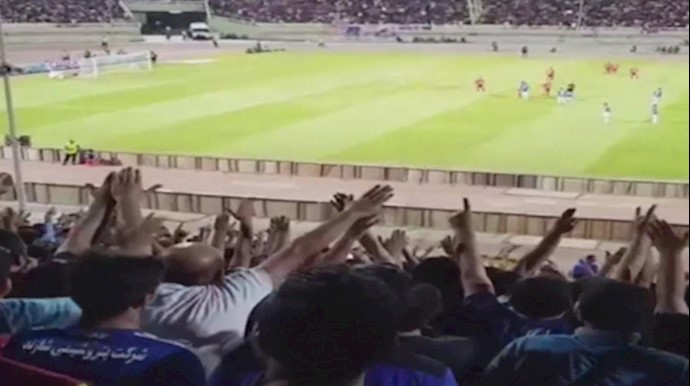Analysis by PMOI/MEK
Iran, Aug. 13, 2018 – The Iranian regime has a track record of successfully cracking down on any form of dissent that doesn’t play by the unwritten rules of the power games played in the Iranian political establishment. There is always an invisible—nonetheless prominent line—between what they call “legitimate grievances” and opposition to the whole system.
The concept of the smart crackdown is nothing new. Dictators throughout history, with the help of their apologists inside and outside of the country, have mastered it to the very last detail. Great Britain’s appeasement policy toward Nazi Germany in the power struggle that led to World War Two is well documented.
But what has made the recent popular protests in Iran since December 2017 immune to these tactics is the smart way the Iranian people are playing their hand.
Protesters across different ethnic and economic groups and unrelated physical locations throughout the country are playing a relay race against the Iranian regime’s crackdown tactics. While the government manages to take control of a particular city or district, protesters in another city start a new round of demonstrations as if they’ve received the baton.
“Death to Dictator” is the new chant in stadiums
On 10th August, a popular soccer match between the teams of Tabriz and Tehran turned into a protest where visitors of the Azadi stadium in Tehran chanted: “Death to the dictator!”
Matches between the two teams are historically loaded. Tabriz’s population are Azaris and the Iranian regime engineers them to sow ethnic clashes between the Azari and Fars population. Divide and conquer, as the mantra goes, is one of the oldest tactics of a smart crackdown policy.
And for the icing on the ethnic solidarity regime change cake, the Azaris present at the match sang a beautiful song in their native Azari language at the end of the match: “All of Iran is my homeland; long live Azerbaijan.”
24 hours later, fake videos of the match with edited audio where Azaris chant insults at Persians surfaced on social media. That was the Iranian Ministry of Intelligence’s backlash against what had really happened in the stadium: Solidarity between different ethnicities against the whole regime.
Strike at Tehran’s Bazaar
The very next day, Saturday the 11th August, merchants of Tehran’s shoe bazaar, closed their stores in protest to high prices and a lack of access to basic goods necessary for their line of work. Intelligence officers were on the ground trying to dissuade merchants from shutting down their business with threats and promises.
The strike of Tehran’s shoe bazaar has continued today with the merchants chanting “Death to high prices” and “Death to the dictator.”
Strike in Iran’s railroads
On 11th August the Council of Organization for Railroad Workers issued a statement saying that their strike which had started more than 2 weeks ago will continue until they receive their unpaid wages. The railroad council’s statement continues, “Our movement has become widespread because we haven’t achieved any results with the employers.”
Other recent instances of strikes and protests
- On 8th August, beet farmers protested in the sugar factory of Naqadeh asking for their payments. Iranian authorities responded that there is no money right now.
- Kermanshah: protest of municipal workers
- Kharg Island: protest of workers of Falat Ghareh
- Mashhad: protesters gather demanding their stolen money from Padideh Shandiz, a state-backed financial institution.
Frequent appeals for strikes and protests on social media
Social media is one of the few public channels in Iran where Iranians can express their dissent and protest the Iranian regime without fear of retribution. Many Iranians have anonymous accounts on social media where they speak freely against the Iranian regime and invite their fellow citizens to strike and protest.
It’s worth mentioning that major social media platforms, except for Instagram, are filtered in Iran. Facebook and Twitter are banned since the 2009 election protests. Telegram, a very popular messaging and social media app in Iran with over 40 million users, has been banned recently by the “moderate” government of Hassan Rouhani.
While most social media campaigns don’t lead to real protests and strikes on the ground, they keep the regime’s forces occupied with prevention measures. Deploying anti-riot forces on a daily basis and keeping them in the field wears them down physically and mentally.
Pictures of soldiers with burned backs and blistered feet make the rounds of Iranian social media circles these days. Some soldiers and commanders go as far as sending social media activists messages asking them to keep up the invitations. Their reasoning: They can’t keep staying on alert and the troops are tired of roaming the streets.
Final thoughts
The diversity of protests, in ethnicity, location, type of protest, and economic background of the protesters coupled with a downward spiraling economy are what makes this new smart type of protests possible. This time it seems that the so-called smart type of crackdown by the Iranian regime coupled with the false hope of moderation doesn’t pay off anymore leading to the dilemma where they have to choose to show their real murderous face or back off and retreat into the grave.
Let’s hope for a free and democratic Iran in the near future where a prosperous economy will pave the way for our future generations.





